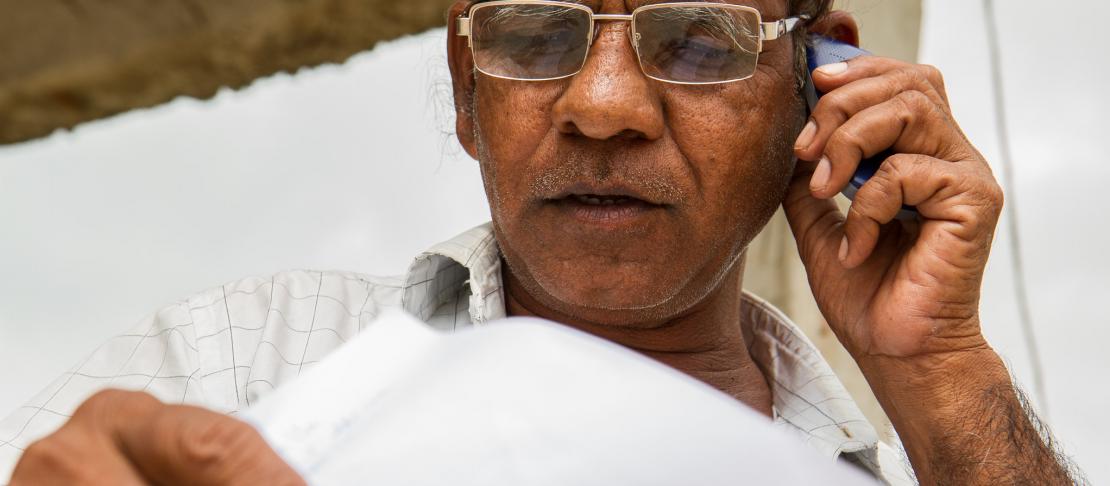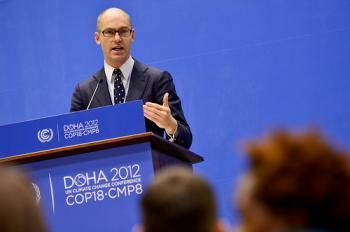Tried and tested solutions for food and farming as climate changes

by Olive Thiong'o
While hopes may be fading that the UN Framework Convention on Climate Change to approve a formal work plan for agriculture at the Doha talks, climate action on agriculture is already taking place. Several countries have taken the lead and committed to initiatives on adaptation and mitigation. These successful, large-scale initiatives were presented at a recent side event hosted by the CGIAR Research Program on Climate Change, Agriculture and Food Security (CCAFS). The side event, Lessons Learnt from Scaling-Up Actions on Food Security, Adaptation and Mitigation, featured a panel of experts sharing evidence-based lessons from initiatives in Australia, India and Ethiopia.

James Kinyangi shared key lessons from a CCAFS study on the large-scale implementation of adaptation and mitigation actions in the agriculture and food sector which includes 14 examples from around the world. These initiative focus on climate risk management, agricultural initiatives with a strong link to climate change adaptation and mitigation, national policies or strategies aims, and national policies or strategies side effects.
These case studies yielded five cross-cutting lessons that have been learned, notably: trade-offs can often be avoided; there’s need for cost-effective and comparable indices for measuring GHG fluxes and adaptive capacity; upfront costs may be substantial; and that an iterative learning approach with investment in capacity strengthening is critical.
Ethiopia’s Productive Safety Net program (PSNP), presented by Catherine Zanev, a Policy Officer of the World Food Programme, showed that safety nets are key in having impact at a large scale, but that they must be must be flexible and scalable to remain sustainable, and that a conscious investment in communities’ capacities needs to be made, in order to reach both long-term and short-term goals.
In India, a program bringing agro-meteorological information to farmers was presented by Kalpana Venkatasubramanian from CCAFS South Asia. Under this program, small farmers in India have benefited from weather advisories via mobile phones. Her study on Good Practices in Climate Services showed that the involvement of women in agricultural communication and the choice of communication channels are critical in influencing change on agricultural practices.
While adaptation and safety nets form one part of climate-smart agriculture, the other side of the story is mitigation. Food system emissions—from production to consumption—contribute 9,800 to 16,900 million metric tonnes of carbon dioxide equivalent (MtCO2e) per year, or 19 to 29 percent of total greenhouse gas emissions. Rob Sturgiss, Assistant Secretary in the Land Division of the Department of Climate Change and Energy Efficiency, Government of Australia, shared experiences from Australia’s Carbon Farming Initiative. The programme has successfully boosted both agricultural production and soil carbon, in a country where drought and land degradation are increasing as climate changes.
The emerging unanimous lesson from these case studies is the importance of the government in projects and programs, in achieving the set objectives. Governments need to be made aware of the importance of climate change: its tremendous gains versus possible tremendous losses, so as to take ownership of these adaptation and mitigation projects and programs that scale-up food security.
Overall, session Chair Patrick Verkooijen of the World Bank emphasized that food security is the main concern: “Farmers are concerned with agricultural productivity and resilience; carbon payments are icing on cake,” he said.
In the discussions it was implied that for food security to be reached in this era of climate change, it pays to learn from and scale up existing, successful programs, rather than re-inventing the wheel with new initiatives. It is also apparent that adaptation and mitigation are two sides of the same coin; most agricultural practices that enhance productivity and resilience also store carbon. With this in mind, it is remarkable that negotiations have not put the two together, but clear examples of success should be widely shared in order to inspire further action.
Download the background document: The large-scale implementation of adaptation and mitigation actions in the agriculture and food sector.
Olive Thiong'o is a Communications Officer at CCAFS East Africa program. Follow the latest developments from the UN climate talks in Doha on our blog, on Twitter @cgiarclimate and #ALLForest.